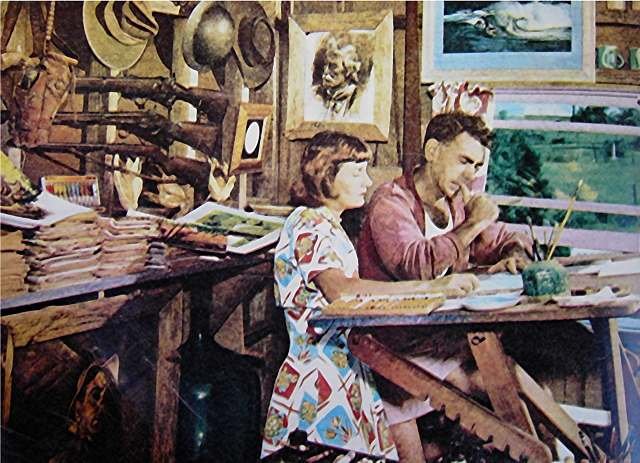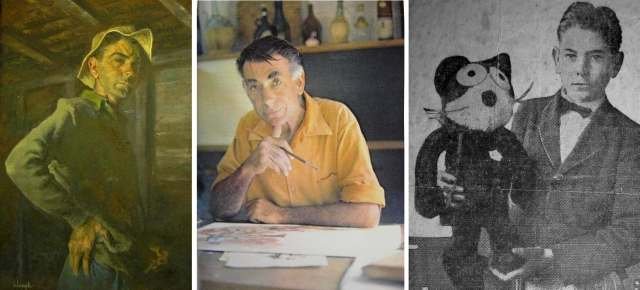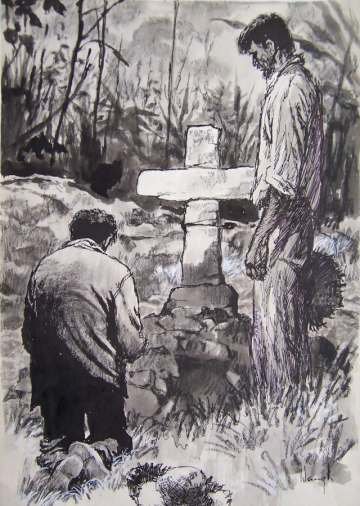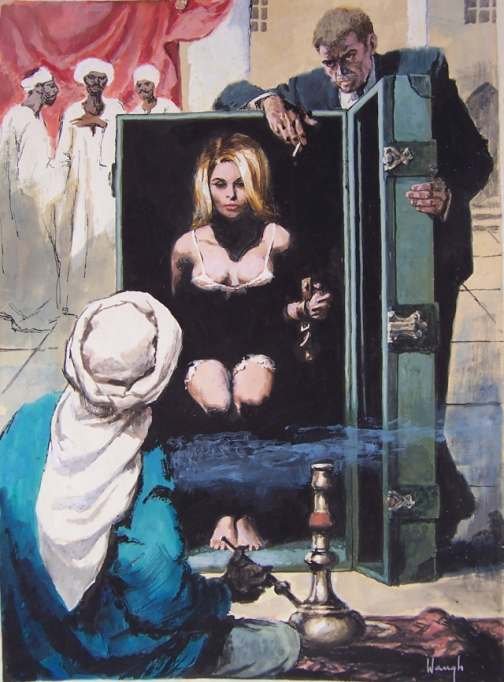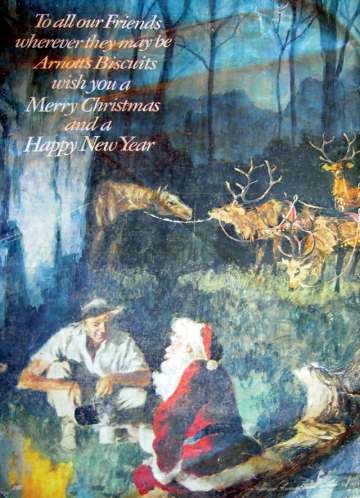| bc | John Edward (Jack)
Waugh, Australian Artist and Illustrator
John Edward (Jack) Waugh was a prolific commercial artist and illustrator whose work appeared in many Australian publications. He was one of the artistic mainstays of the K.G. Murray publishing group and his illustrations were a prominent feature in such titles as Man, Man Junior, Adam and Cavalcade. His glorious double-page paintings – like those of fellow artist Phil Belbin – adorned the pages of Man through its heyday in the late 1940s and 50s to the end of the magazine’s life in the 1970s. Perhaps his best-known single illustration, however, was painted for the Arnotts biscuit company in 1964 and appeared on the back page of the Australian Woman’s Weekly several times over a number of years. The picture showed Santa Claus pausing for a rest by a country wayside, sharing a billy of tea (and some biscuits) with a wiry Aussie drover. The drover was Waugh himself (he often modelled for his own pictures in a mirror) and the picture was such a hit with Arnotts and the public that instead of appearing once only it was republished year after year at Christmas time. Eventually Arnotts, in recognition of Waugh’s creation of a powerful and valuable image, paid him an extra cheque and thanked him for his inspiration. In a way, the outwardly tough but inwardly sentimental drover is a fitting symbol of the independent, self-reliant and outdoorsy ex-serviceman whose strongly masculine drawing style co-existed with a passion for nature, the bush and conservation. Jack Waugh was born in Lakemba on May 17, 1910 and grew up in Glebe. From his early years was interested in drawing and making things. An old press clipping shows young Jack, aged perhaps 12, proudly accepting first prize in a “Felix the Cat” drawing contest run by the Haymarket Theatre. At 14 Jack was taken into an uncle’s signwriting business “to make the tea”. Instead, he added the commercial art skills he was able to learn there to his native abilities. Waugh’s son Andrew has a copy of a hand-written diary kept by his father during a long tramp he did with a mate called Clem just before Australia and Japan went to war. The pair walked from Sydney to Brisbane, with Jack partly subsidising the trip by drawing caricatures of people they met at four shillings a go. On the NSW North Coast they earned some money from timber felling, bought a horse and sulky and continued to Coolangatta. In Brisbane the pair joined the armed forces, with Jack going into signals and becoming a motorcycle despatch rider. At a dance in Brisbane he met his future wife, Phyllis Rose, and the pair married on January 10, 1942. They were later to have three sons – John, Andrew and Bradley – and a daughter, Patricia. Long motorbike rides on dusty outback roads with inadequate goggles caused lifetime damage to Jack’s eyes and he was discharged on medical grounds in 1944. For the rest of his life he said that he saw things “as though through a church window”. This did not interfere with his superb draughtsmanship, however, and his bold, eye-catching work was soon appearing in many publications. He entered a striking self-portrait in the Archibald Prize in 1948. This work was painted on a cow-rug because of the shortage of canvas. It received favourable comment from the judges and remains a prized possession of the Waugh family. Son Andrew recalls watching his father working in his studio with a range of props such as guns and other items commonly called for in his magazine illustrations. When Murrays commissioned artwork, Andrew said, they would nominate the colours they wanted to predominate in the illustration. Jack would read the story and do some drafts from which a successful composition would be chosen.
Fortunately, Jack’s family has preserved a number of examples of their father’s original pieces of artwork.
Jack Waugh died on October 16, 1996. |
bc |
